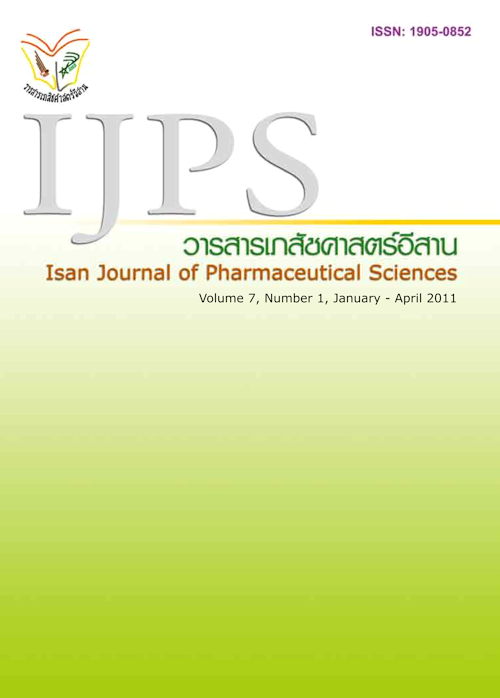การใช้ยาในมิติทางสังคมวัฒนธรรมของชุมชนเขตเมือง
Main Article Content
บทคัดย่อ
บทนำ: การศึกษาปัญหายาในชุมชนจะพบความจริงอย่างหนึ่งร่วมกันว่า ยังขาดมิติในมุมของทางด้านสังคมและวัฒนธรรมร่วมอยู่ด้วย อีกทั้งชุดความรู้เกี่ยวกับปัญหาการใช้ยาส่วนใหญ่มักทำการศึกษาในภาคชนบทเป็นหลัก ซึ่งไม่น่าจะเป็นความรู้ชุดเดียวที่จะใช้อธิบายปัญหาการใช้ยาที่เกิดขึ้นกับชุมชนในเขตเมืองได้อย่างเพียงพอ ความรู้ที่ได้จากการศึกษานี้จะช่วยเติมเต็มช่องว่างระหว่างบรรทัดของชุดความรู้เกี่ยวกับการใช้ยาในชุมชนให้สมบูรณ์และครอบคลุมมากยิ่งขึ้น วิธีวิทยา: ทำการศึกษาชุมชนดอนหญ้านาง เขตเทศบาลนครขอนแก่น ระหว่างเดือนมีนาคม – สิงหาคม 2553 และเก็บรวบรวมข้อมูลจากครัวเรือนที่มีคนหลายวัยอยู่อาศัยร่วมกัน จำนวน 50 ครัวเรือน โดยใช้วิธีการสังเกตแบบมีส่วนร่วม การสัมภาษณ์เจาะลึก สนทนากลุ่ม บันทึกภาคสนามและภาพถ่าย ผลการศึกษา: พบว่าผู้คนในชุมชนเมืองจะบริโภคยาที่ความหมายแฝงของยา (Exchange value) ซึ่งรวมไปถึงสินค้าที่ถูกผลิตสร้างขึ้นมาเพื่อเป็นสัญญะ (Sign) ของยาด้วย สิ่งที่อยู่เบื้องหลังและเร่งเร้าให้เกิดการบริโภคคือ ความไม่ต้องการเป็นอื่น (The Otherness) ในสังคมที่เรียกว่า ความไม่ต้องการเชย ไม่ร่วมสมัยและไม่ตกยุค กลุ่มคนชั้นกลางระดับสูงในเมืองจะใช้ยาและสัญญะของยาเพื่อบอกความเป็นตัวตน รสนิยมและเพื่อการเป็นส่วนหนึ่งของกลุ่มทางสังคม กลุ่มคนชั้นกลางระดับล่างจะบริโภคยาในรูปแบบสัญญะซ้อนสัญญะเพื่อทำให้ภาพความเป็นอื่นที่ถูกสร้างว่าเป็นความเชยในสังคมเมืองเจือจางลง กลุ่มคนชายขอบบริโภคสัญญะของยาเพื่อความเสมอภาคและทัดเทียมกับคนกลุ่มอื่นๆ ในสังคมและบริโภคนิยมก็ได้สร้างให้เกิดความเป็นอื่นหรือความเชยของการใช้ยาชุดในเมืองปรากฏขึ้นในสังคมอีกด้วย สรุปผลการศึกษา: การใช้ยาของคนในชุมชนเมืองล้วนแล้วแต่เชื่อมโยงกับบริโภคนิยม (Consumerism) และสัมพันธ์กับกลุ่มชนชั้นทางสังคม (Social class)
Article Details
กรณีที่ใช้บางส่วนจากผลงานของผู้อื่น ผู้นิพนธ์ต้อง ยืนยันว่าได้รับการอนุญาต (permission) ให้ใช้ผลงานบางส่วนจากผู้นิพนธ์ต้นฉบับ (Original author) เรียบร้อยแล้ว และต้องแนบเอกสารหลักฐาน ว่าได้รับการอนุญาต (permission) ประกอบมาด้วย
เอกสารอ้างอิง
Chadbunchachai S. Epidemiology and Public Attitudes: YA – CHUD in Rural and Urban Section. Nonthaburi: Food and Drug Administration; 1996.
Chadbunchachai S, Ulvapark V, Eungpinichpong W.The muscoloskelatal pain be haviors and a model for solving the problem in the commu-nity : study in 2 villages, Northeast Thailand. Krung Thep Mahanakorn: Health System Research Institute; 2000.
Chuengsatiarsap K. Muksong C, Trunksisat N. Health Dynamics of self-reliance: Urban Section. Nonthaburi: Society and Health Institute; 2004.
Chuengsatiarsap K. Pluralistic Health Care System in Social and Cultural Dimension. Krung Thep Mahanakorn: Pimpdee; 2006.
Eawsriwong N. Cultural of Urban. Cities with urban culture and the changes in Bangkok Metropolitan Region. Krung Thep Mahanakorn: Princess Maha Chakri Sirindhorn Anthropology Centre. Silapakorn University; 1998.
Hongsamoot D. The study of YA – CHUD. Nonthaburi. Food and Drug Administration; 1992.Kleinman, A. Patient and Healers in the Context of Culture. Berkley: University of California Press; 1980.
Lock, Magaret. Encounter with Aging: Mythologies of Menopause in Japan and North America. Berkley: University of California Press; 1993.
Geest S, Whyte SR, Hardon A, Social Lives of Medicine. Cambridge: Cambridge University Press: 2002
Sringanyuang L, Hongviwat T, Pradubmuk J. Drug Use of Corticosteroids in Rural Section of Thailand, Social and Economic Situation and Characteristics; 1994.


